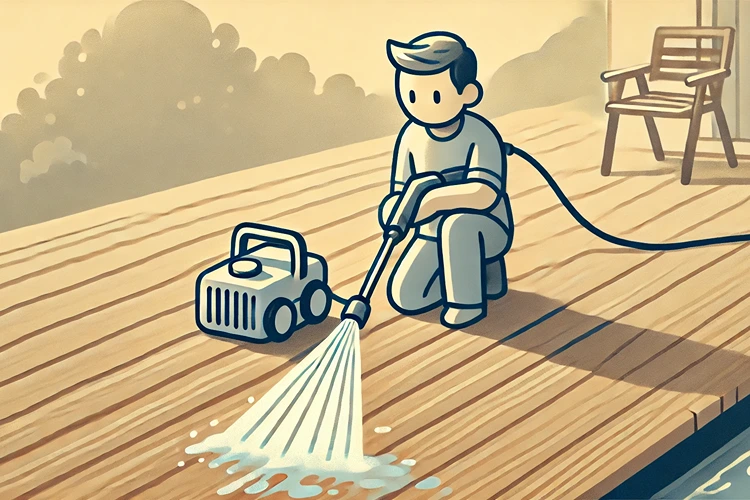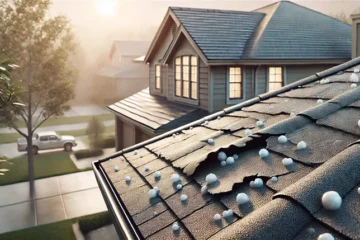Best Practices for Power Washing Your Deck Without Damage

Power washing your deck is a fantastic way to keep it looking fresh and clean, but it can also be a risky task if not done correctly. The process involves using high-pressure water to remove dirt, mold, and other debris, but too much pressure or the wrong technique can easily damage the wood. This guide will walk you through the best practices for power washing your deck without causing any harm. By the end, you’ll know exactly how to get your deck looking like new while preserving its integrity.
Why Power Washing Is Essential for Deck Maintenance
Over time, your deck is exposed to a variety of elements—rain, sun, dirt, and more—that can cause it to look worn and aged. Power washing is one of the most effective ways to rejuvenate your deck, removing the grime that accumulates and bringing out the natural beauty of the wood. But it’s not just about aesthetics; regular cleaning also helps to prevent the buildup of mold and mildew, which can lead to rot and other structural issues.
Helpful Hint:
Power washing your deck at least once a year can significantly extend its lifespan. Make it part of your annual home maintenance routine to keep your outdoor space in top condition.
What Are the Risks of Power Washing Your Deck?
While power washing is an effective cleaning method, it comes with some risks. The high pressure can easily gouge or splinter the wood if not done carefully. Additionally, if water gets trapped in the wood, it can cause swelling and eventually lead to rot. Understanding these risks is the first step in preventing damage.
Is Power Washing Suitable for All Deck Types?
Not all decks are created equal, and the material your deck is made from will determine how you should approach power washing. Wooden decks, particularly those made from softer woods like cedar or pine, are more susceptible to damage from high-pressure washing. On the other hand, composite decks are generally more durable, but they can still suffer from discoloration or surface damage if not cleaned correctly.
How to Prepare Your Deck for Power Washing
Before you even turn on the power washer, proper preparation is crucial. This involves clearing the deck of all furniture, plants, and other items that could be damaged or get in the way. You’ll also want to inspect the deck for any loose boards or nails, as these can be hazardous during the washing process. Finally, consider applying a wood cleaner to help loosen dirt and stains, making them easier to remove with the power washer.
Should You Use a Detergent?
Using a detergent can make the power washing process more effective, especially if your deck has a lot of built-up grime. However, it’s important to choose a detergent that’s safe for wood and won’t leave behind any harmful residues. In most cases, a biodegradable cleaner is your best option, as it’s effective and environmentally friendly.
How to Protect Surrounding Areas
Power washing can cause debris to fly everywhere, so it’s important to protect the surrounding areas of your deck. Cover nearby plants, outdoor furniture, and walls with plastic sheeting to shield them from the high-pressure spray. You may also want to wet down plants and grass before you start, as this can help minimize any damage from overspray.
Helpful Hint:
Consider using a tarp to cover delicate plants or flower beds around your deck. This will provide an extra layer of protection against any stray water or debris that might come off during the cleaning process.
Choosing the Right Power Washer and Settings
The power washer you choose and the settings you use are critical to avoiding damage to your deck. For most decks, a pressure setting between 500 to 600 PSI is sufficient to remove dirt without harming the wood. If you’re using a gas-powered washer, start at the lowest setting and gradually increase the pressure if needed. Also, be sure to use a fan tip nozzle, which disperses the water over a wider area, reducing the risk of damage.
What Nozzle Should You Use?
The nozzle you use will have a big impact on how safe and effective your power washing is. Fan tip nozzles, which spread the water out in a wide, even pattern, are the safest option for wood decks. Avoid using a zero-degree nozzle, as this concentrates the water into a single point, making it much more likely to damage the wood.
Electric vs. Gas-Powered Washers: Which Is Better?
Both electric and gas-powered washers have their pros and cons. Electric washers are generally less powerful, which makes them a safer option for wooden decks, but they may struggle with more stubborn dirt and stains. Gas-powered washers offer more power and versatility but come with a higher risk of damaging the deck if not used carefully. Your choice will depend on your specific needs and the condition of your deck.
Stats:
A study found that electric power washers are up to 30% less likely to cause damage to wood surfaces compared to gas-powered models. This makes them a preferred choice for deck maintenance among homeowners.
Comparing Power Washing Pressure Settings for Different Deck Materials
| Deck Material | Recommended Pressure (PSI) | Special Considerations |
|---|---|---|
| Cedar | 500-600 PSI | Use a wide-angle nozzle to prevent gouging the soft wood. |
| Pine | 500-600 PSI | Avoid washing against the grain to prevent splintering. |
| Composite | 1500-2000 PSI | Test in a small area first to avoid discoloration. |
| Pressure-Treated Wood | 1200-1500 PSI | Allow wood to dry completely before sealing or staining. |
Step-by-Step Guide to Power Washing Your Deck
Now that you’ve prepared your deck and selected the right equipment, it’s time to get down to the actual washing. Follow these steps to ensure a thorough clean without causing any damage:
- Start by wetting down the deck with a low-pressure spray. This helps to loosen dirt and makes it easier to clean.
- Working in small sections, apply the detergent (if using) and allow it to sit for a few minutes to break down the grime.
- With your power washer set to the lowest effective pressure, begin washing the deck, keeping the nozzle at least 12 inches from the surface. Move in smooth, even strokes, following the grain of the wood.
- Rinse the deck thoroughly with clean water, again using a low-pressure setting.
- Allow the deck to dry completely before replacing furniture or applying any sealants or stains.
Following these steps will help you achieve a clean, fresh deck without the risk of damage.
How Long Should You Wait to Seal or Stain Your Deck After Power Washing?
After power washing, it’s essential to allow your deck to dry completely before applying any sealants or stains. This typically takes 48 to 72 hours, depending on the weather conditions. Sealing or staining too soon can trap moisture in the wood, leading to peeling and other issues down the line.
How to Dry Your Deck Properly After Power Washing
Drying your deck properly after power washing is just as important as the washing itself. Leaving the wood wet for too long can lead to warping, mold growth, and even rot. The drying process can be influenced by several factors, including weather conditions, deck material, and the time of day when the washing is done.
What’s the Best Time of Day to Power Wash and Dry Your Deck?
The best time of day to power wash your deck is in the morning when the sun is starting to rise, but it’s not too intense. This gives the deck plenty of time to dry throughout the day. Washing your deck later in the day can lead to prolonged dampness, especially if the temperature drops in the evening, increasing the risk of mold and mildew growth.
Should You Use a Leaf Blower to Speed Up Drying?
While it’s tempting to use a leaf blower or similar device to speed up the drying process, it’s generally not recommended. Forced air can push water deeper into the wood, increasing the risk of damage. Instead, rely on natural drying or, if necessary, use fans to create gentle airflow around the deck.
Sealing and Staining Your Deck: When and How to Do It Right
After power washing and allowing your deck to dry completely, sealing or staining is the next critical step. This not only enhances the appearance of the wood but also provides protection against the elements. However, applying these products requires care to avoid streaks, uneven coverage, and other common issues.
Should You Seal or Stain First?
Whether to seal or stain your deck first depends on the product you’re using. Some stains include a sealer, while others require you to apply a separate sealant. If you’re using two separate products, staining should be done first, as it penetrates the wood and provides color, while the sealer sits on top to protect it.
How Often Should You Reapply Sealant or Stain?
The frequency of reapplying sealant or stain depends on several factors, including the type of wood, the quality of the product used, and the local climate. As a general rule, you should plan to reseal or restain your deck every 1-3 years. High-traffic areas may need attention more frequently, while shaded areas might last longer between applications.
Helpful Hint:
Consider using a semi-transparent stain, which provides UV protection and water resistance while still allowing the natural grain of the wood to show through. This type of stain typically needs to be reapplied less often than solid stains.
Common Mistakes to Avoid When Power Washing Your Deck
Even with the best intentions, mistakes can happen during power washing that may result in costly repairs or irreversible damage. Understanding these common pitfalls can help you avoid them and keep your deck in pristine condition.
Using Too Much Pressure
The most common mistake people make when power washing their deck is using too much pressure. High pressure can strip away not only dirt and grime but also the wood fibers themselves, leaving the surface rough and splintered. Always start with the lowest pressure setting and only increase it if necessary.
Washing Against the Grain
Power washing against the grain of the wood can cause deep grooves and uneven wear on your deck. Always move the nozzle in the direction of the wood grain to avoid these issues. This method helps to preserve the natural appearance of the wood while effectively removing dirt.
Not Rinsing Thoroughly
Failing to rinse your deck thoroughly after applying detergent can leave behind residue that can harm the wood and make it more susceptible to future staining. Make sure to rinse each section of the deck completely, ensuring that all soap and dirt are washed away.
When to Call in a Professional
While many homeowners prefer to power wash their decks themselves, there are times when calling in a professional is the best option. Professional power washers have the experience and equipment to handle even the toughest jobs, reducing the risk of damage to your deck.
Is Your Deck Severely Weathered or Damaged?
If your deck is old, severely weathered, or already showing signs of damage, it’s wise to consult a professional before power washing. They can assess the condition of the wood and recommend the best course of action, whether it’s a gentle cleaning or more extensive repairs.
Are You Uncertain About Using a Power Washer?
If you’re unsure about how to use a power washer or are worried about damaging your deck, hiring a professional can provide peace of mind. They have the knowledge and expertise to clean your deck safely and effectively, saving you time and potential headaches.
What Should You Expect from a Professional Service?
When hiring a professional, you should expect a thorough inspection of your deck, careful selection of the appropriate pressure settings and detergents, and a detailed cleaning that leaves your deck looking like new. A good professional will also offer advice on ongoing maintenance to keep your deck in top shape.
Stats:
According to industry experts, professional power washing services can extend the life of your deck by up to 50%, especially when combined with regular maintenance like sealing and staining.
Pros and Cons of Power Washing Your Deck
Pros
- Effective removal of dirt, mold, and mildew, enhancing the appearance of your deck.
- Helps to prepare the deck for sealing or staining, ensuring better adhesion and longer-lasting results.
- Power washing can reach areas that are difficult to clean by hand, such as gaps between deck boards.
- Regular cleaning through power washing can extend the lifespan of your deck by preventing rot and decay.
- Reduces the risk of slips and falls by removing algae and moss that can make surfaces slippery.
Cons
- High-pressure washing can damage wood, causing splintering, gouging, and even warping if not done correctly.
- Water can get trapped in the wood, leading to potential rot or mold growth if the deck is not dried properly.
- Improper use of power washers can strip away natural oils from the wood, leaving it more susceptible to weathering.
- Power washing can be time-consuming and may require multiple passes to achieve a thorough clean.
- There is a risk of injury if the equipment is not handled properly, especially with gas-powered washers.
FAQs
Wrapping Up
Maintaining the beauty and integrity of your deck through power washing is a task that requires careful attention and the right techniques. By following the best practices outlined in this guide, you can ensure that your deck remains a safe, clean, and welcoming space for years to come. Remember, the key to successful power washing is balancing effectiveness with caution to avoid unnecessary damage.
Whether you’re tackling the job yourself or hiring a professional, understanding the intricacies of power washing will help you achieve the best results. Keep these tips in mind as you care for your deck, and you’ll be rewarded with an outdoor space that looks great and lasts longer.
For more expert advice on home improvement and maintenance, stay tuned to our blog, where we share valuable insights and tips to help you keep your home in top shape.


